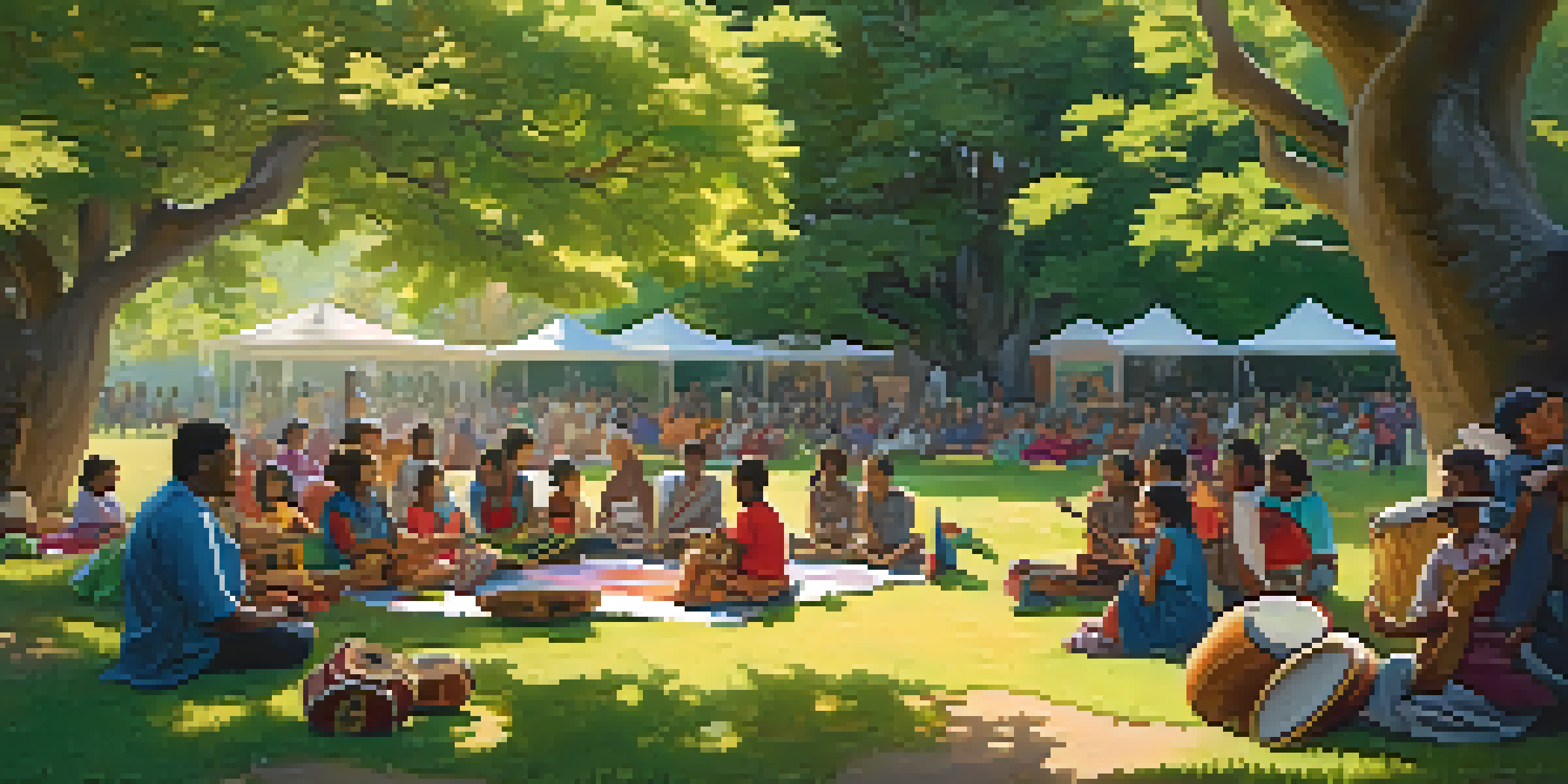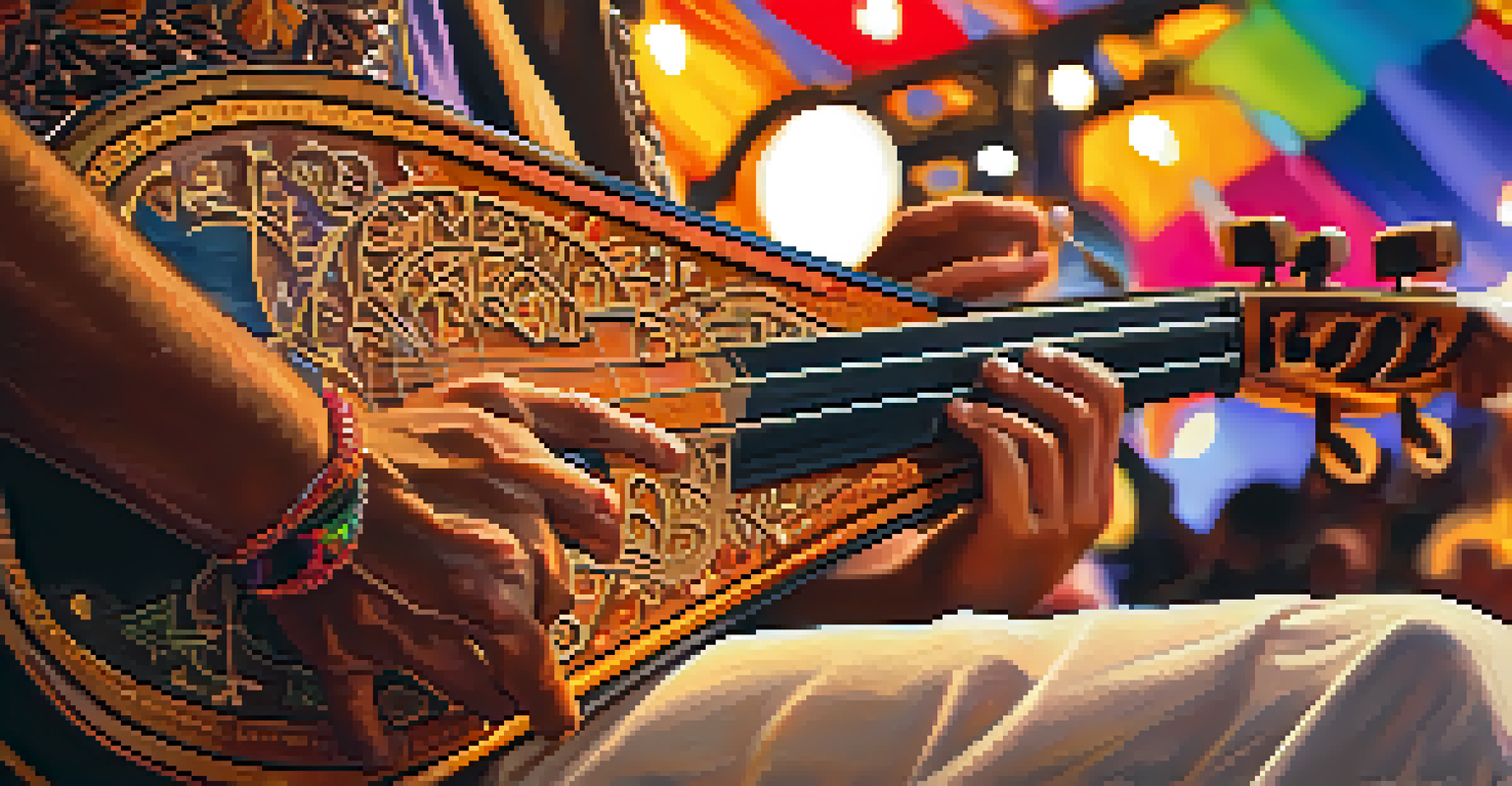Folk Tales and Tunes: Preserving Culture Through Music

Understanding Folk Tales and Their Significance
Folk tales are more than just stories; they are the heartbeat of a culture. Passed down through generations, these narratives capture the values, beliefs, and history of a community. They often feature relatable characters and moral lessons, making them a timeless form of entertainment and education.
Stories are a communal currency of humanity.
In many cultures, folk tales serve as a means of preserving language and traditions. For example, Native American stories often incorporate nature, emphasizing respect for the environment. This connection not only teaches children about their heritage but also instills a sense of responsibility toward the world around them.
As we dive deeper into these tales, we find that they often reflect the struggles and triumphs of the people. They provide insight into societal norms and can even inspire social change, allowing cultures to evolve while holding onto their roots.
The Role of Music in Cultural Narratives
Music has a unique way of capturing emotions and stories, making it an essential partner to folk tales. Songs often accompany tales, enhancing the narrative and making it more memorable. Think of a traditional ballad that tells the story of a hero's journey, where each note evokes a different emotion.

In various cultures, music serves as a vital tool for storytelling. For instance, in West African cultures, griots use music to recount the history and achievements of families and communities. This oral tradition not only keeps history alive but also strengthens the bonds within the community.
Folk Tales Preserve Cultural Heritage
Folk tales encapsulate the values and history of communities, serving as a vital link between generations.
Moreover, the melodies and rhythms of folk music often reflect the environment and lifestyle of the people. This connection to place adds layers of meaning to the stories, inviting listeners to experience the culture in a deeper way.
Intertwining Folk Tales and Music
The relationship between folk tales and music is beautifully intertwined. Many folk songs are derived from stories, encapsulating the essence of the narrative within a simple melody. This fusion allows listeners to engage with the tale on multiple levels, making it more impactful.
Music can change the world because it can change people.
For instance, the Scottish ballad 'Tam Lin' narrates a tale of love and bravery, illustrating how music can bring stories to life. The melody often changes with the emotions of the story, drawing listeners into the drama and excitement of the plot.
Additionally, this combination fosters community participation. When people gather to share songs and stories, they create a collective memory, reinforcing cultural identity and continuity across generations.
Preservation Through Performance
The performance of folk tales and music is a crucial aspect of cultural preservation. Festivals and community gatherings often feature storytelling and music, making them vibrant celebrations of heritage. These events create an immersive experience that keeps traditions alive.
Performers play a key role in this preservation, as they breathe life into age-old tales and melodies. Whether it's a local musician strumming a guitar or a storyteller captivating an audience, their passion helps ensure that these cultural expressions endure.
Music Enhances Storytelling Experience
The integration of music with folk tales enriches the narrative, making stories more memorable and engaging.
Moreover, as new generations participate in these performances, they learn the stories and songs firsthand. This hands-on experience fosters a sense of pride and belonging, encouraging young people to carry on their cultural legacy.
The Impact of Technology on Folk Traditions
In today's digital age, technology plays a significant role in the preservation of folk tales and music. Platforms like YouTube and social media allow artists to share their work with a global audience, breaking down geographical barriers. This exposure can breathe new life into traditional stories and melodies.
However, while technology can be a powerful tool for preservation, it also presents challenges. The risk of cultural appropriation and misrepresentation can arise when stories and music are shared out of context. It's important for creators and consumers to be mindful of the origins and significance of these cultural expressions.
Ultimately, technology can serve as a bridge, connecting diverse cultures and fostering appreciation for folk traditions. By sharing these rich narratives and tunes online, we can ensure they remain relevant and cherished in a rapidly changing world.
Folk Tales and Music in Modern Society
In modern society, folk tales and music continue to resonate, often finding new interpretations. Artists are blending traditional elements with contemporary styles, creating a fusion that speaks to both old and new audiences. This evolution keeps folk traditions alive while making them accessible to a wider audience.
For example, folk musicians today might incorporate electronic sounds or modern lyrics while retaining the essence of traditional stories. This creative process not only honors the past but also invites dialogue about cultural identity in a globalized world.
Technology Affects Folk Traditions
While technology aids in preserving folk tales and music, it also poses challenges like cultural appropriation.
As we navigate our increasingly interconnected lives, folk tales and music remind us of our roots. They encourage us to reflect on our individual and collective identities while celebrating the rich tapestry of human experience.
The Importance of Teaching Folk Traditions
Teaching folk tales and music to younger generations is vital for cultural preservation. By introducing children to these stories and songs, we instill a sense of pride and belonging. This education also fosters an appreciation for diversity, encouraging respect for different cultural expressions.
Schools and community programs can play a significant role in this process. Workshops that focus on traditional storytelling and music not only engage kids creatively but also help them understand the historical context of these cultural forms. This hands-on learning can spark a lifelong interest.

Ultimately, when we prioritize the teaching of folk traditions, we empower the next generation to carry the torch. They become the storytellers and musicians of tomorrow, ensuring that cultural heritage continues to thrive.